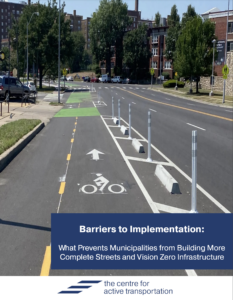The movement for safer and more equitable streets in Ontario has been growing in recent years, with an increasing number of residents demanding improved road safety infrastructure. To meet this demand, municipalities across Ontario have been adopting and expanding approaches in their policies, with two prominent approaches being Complete Streets and Vision Zero.
This report investigates barriers to advancing Complete Streets and Vision Zero policy implementation through two main methods: a scan of Complete Streets and
Vision Zero policy and initiatives in Ontario; and a series of interviews with planners and engineers from seven Ontario municipalities.
This report identified six types of barriers to achieving the stated goals of Complete Streets and Vision Zero policies –
1) Policy and guidelines
The Current policy was deemed inadequate, with insufficient design guidance and a lack of strong rationales for Complete Streets and Vision Zero. Interviewees stressed the importance of Guidelines, which provide operationalizing details, resulting in internal efficiencies.
2) Cultures of opposition
Car culture remains the dominant perspective in the planning and designing of streets. Interviewees noted how a vocal minority of municipal staff, politicians and members of the public oppose Complete Streets and Vision Zero initiatives.
3) Staff coordination
Interviewees noted how municipal staff could fail to notify Complete Streets and Vision Zero teams about relevant road projects. There is a need to facilitate efficient communication between municipal staff.
4) Budging and resources
There were several barriers related to budgeting mentioned by interviewees, including the cost of maintenance for Complete Streets, the need for road widening due to car-centric road planning, and a lack of human resources.
5) Balancing needs
Given the reluctance to implement road diets, interviewees explained how compromises must be reached on which elements are to be implemented and the location of infrastructure to be installed. The decisions that are made have equity implications.
6) Data
Insufficient means of analyzing and distributing data were stressed by practitioners. There is a need for better systems of management, which require greater human resources. Data collection has also faced challenges, such as those posed by COVID.
Read the full report below:

